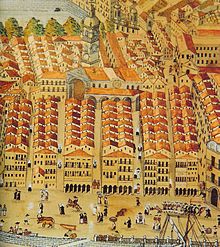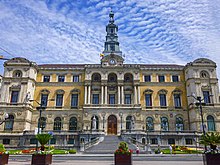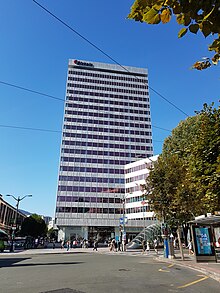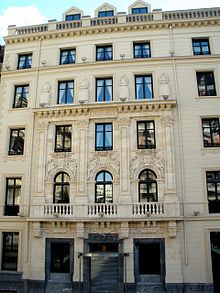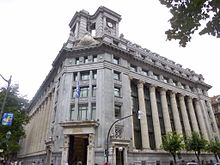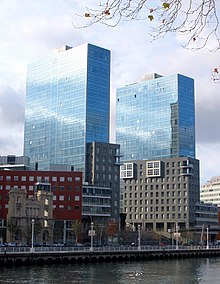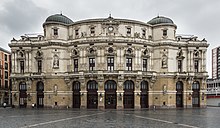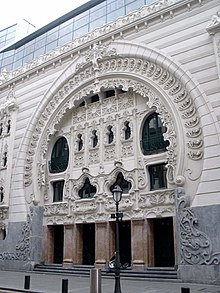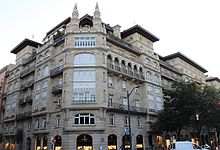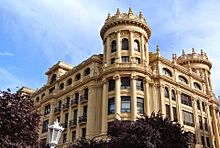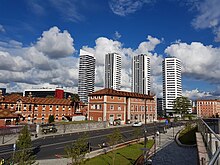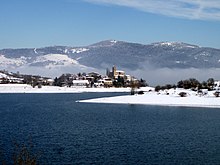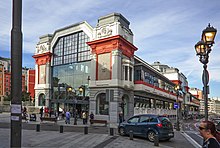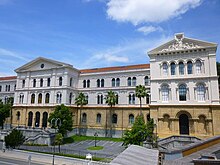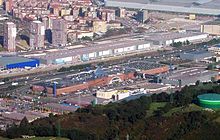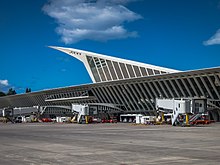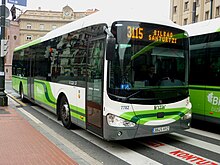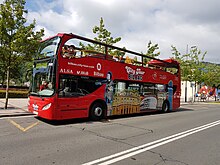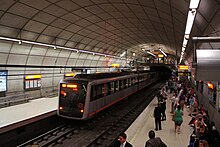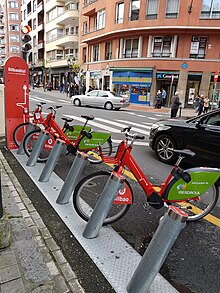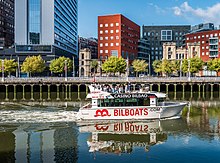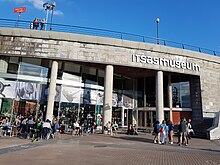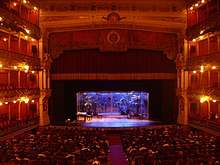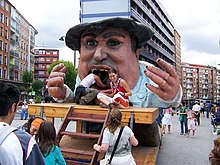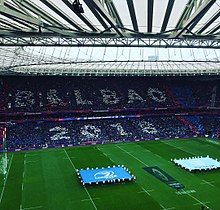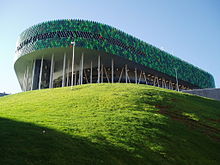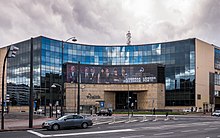Bilbao
Bilbao (in Basque, Bilbo) is a municipality located in northern Spain and a town within that municipality, capital of the province and historical territory of Vizcaya, in the autonomous community of the Basque Country. The town of Bilbao is the capital and only town in the municipality, and with 346,843 inhabitants according to the 2019 census, it is the most populous city in the autonomous community, being the head of the Bilbao metropolitan area, a conurbation of more than 1 000,000 inhabitants that stretches along the Bilbao or Nervión estuary.
The municipality is flanked by two mountain ranges, with an average altitude that does not exceed 400 meters, and which form some of its natural limits. It limits with Erandio, Sondica, Zamudio, Galdácano, Echévarri, Basauri, Arrigorriaga, Alonsótegui and Baracaldo.
Since it was founded at the end of the XIII century, it was a commercial enclave that enjoyed particular importance on the Cantabrian coast thanks to the privileges granted by the Crown of Castilla that allowed the development of a great port activity that was based mainly on the export of wool from Castilla and to a lesser extent the iron extracted from Biscayan quarries. Throughout the 19th century and early XX experienced a strong industrialization that made it the epicenter of the second industrialized region of Spain, behind Barcelona. This was accompanied by an extraordinary demographic and urban explosion that led to the annexation of several municipalities adjoining It is currently a thriving city of services, which is undergoing a process of aesthetic, social and economic revitalization led by the symbolic Guggenheim Museum Bilbao.
On May 19, 2010, the city of Bilbao was recognized with the Lee Kuan Yew World City Prize, awarded by the city state of Singapore, in collaboration with the Swedish Nobel Academy. Considered the Nobel Prize for urban planning, it was awarded on June 29, 2010. On January 7, 2013, its mayor, Iñaki Azkuna, received the 2012 Mayor of the World Award, which is awarded every two years by the British foundation The City Mayors Foundation., in recognition of the urban transformation experienced by the Biscayan capital since the 1990s. On November 8, 2017, Bilbao was chosen the Best European City 2018 at The Urbanism Awards 2018, awarded by the international organization The Academy of Urbanism.
Toponymy
The official name of the municipality, established by the council, is "Bilbao" in both Spanish and Basque. However, the Royal Academy of the Basque Language ruled, in a report requested by the Bilbao City Council itself, that the normative place name in Basque is Bilbo and it appears that way in its Academic Regulation number 145 Bizkaiko herri-izendegia. The latter is documented in abundant documents and literary works in Basque. On the other hand, «Bilbao» appears in Basque only once, in Los refranes de Garibay from the XVI century and XVII, before which the Royal Academy of the Basque Language raises doubts as to whether it was commonly used in Basque at that time Bilbao or it is just a sought-after use for that saying. In any case, when declining in Basque, only Bilbo should be used.
There is no consensus among historians about the origin of the town's name. The engineer Evaristo de Churruca assures that it is a Basque custom to name a place according to its location, so Bilbao would result from the union of the Basque words "river" and "cove": Bil-Ibaia-Bao. In the same way, the historian Javier Tusell argues that it is an evolution of "bello vado". On the other hand, the writer Esteban Calle Iturrino affirmed that the name derives from the two towns that existed on both banks of the estuary, rather than of the estuary itself. The first —where the current Casco Viejo is located— would be called Billa, which in Basque means “pile”, referring to its pile or pile shape. The second, located on the land of the current Bilbao La Vieja neighborhood and of iron tradition, would be called vaho: «vapor», «exhalation». From the unification of these words would arise the place name, which in the past was also named in writing as Bilvao and Biluao, as recorded in its Carta Puebla and subsequent transcriptions of the same.
Gentilic
The name is "bilbaíno, -a", although the popular pronunciation "bilbaino, -a" (sic) is also common. In Basque it is bilbotar, which is also sometimes used in Castilian, generally within the Basque Country. The town is affectionately known by its inhabitants as "el botxo", that is, "the hole", since it is surrounded by mountains. From this nickname is derived the adjective "botxero". Another nickname that the people of Bilbao receive is that of «chimbos», which comes from some birds that were hunted in large numbers in these places during the century XIX.
Symbols
The titles, the flag and the shield are its traditional symbols and are part of its historical heritage, being used in the image of other cities, in protocol acts, for the identification and decoration of specific places or for the validation of documents.
- Titles
Bilbao holds the historical category of town, with the titles of «Very Noble and Very Loyal and Invicta». It was the Catholic Monarchs who granted the title of "Noble Villa" on September 20, 1475 according to the customs of the time, while Felipe III of Spain, by letter of 1603, gave the Villa the dictates and title of "Very Noble and Very Loyal". After the episode of the siege of Bilbao during the First Carlist War, the Queen Governor, on behalf of her daughter, Queen Isabel II, granted the town the title of "Invicta" on December 25, 1836.
- Shield
Its coat of arms is emblazoned as follows:
In the silver field a two-eyed bridge, added to the church of San Antón of its color and to its sinister two wolves of sable walking and stick, on waves of sugar and silver.
It is characterized by the use of figures alluding to the surroundings of the church of San Antón and the Nervión river; The two passing wolves is an emblem derived from the symbol of the house of Haro, founder of the city, and which also appears on the old Vizcaya coat of arms, reproduced in the armories of many families and other Vizcaya municipalities. The emblem appears in the first engraving of Bilbao, made by the Belgian Franz Hohemberg in 1554. From the XIX century, it is usually represented in an oval-shaped shield accompanied by its ornaments from the same period. These elements appear in other popular emblems of the city, such as that of its football club, Athletic Club. They also appear on the arms of the Chilean city of Constitución, in memory of its founding under the name New Bilbao at the end of the century XVIII.
- Flag
The flag that represents it is white with a red canton, in a proportion of three parts long by two parts wide. The red and white colors are the historical colors of the town.
The Royal Order of July 30, 1845 determined the maritime password for the population. This was defined as a white flag with a top red die next to the scabbard. The dice had to be square and the length of its side would have to be equal to half the sheath. Previously, at least since 1511, the ensign worn by the Bilbao Consulate was white with a red Cross of Burgundy. The relationship of the town with the mercantile and marine activities was always very strong coming to share headquarters. In 1603 the new town hall was inaugurated and the headquarters of the town hall and the aforementioned Bilbao Consulate were located there. The intimate relationship that existed led to the Consulate's flag being related as the town's flag by the citizens.
The definition of the maritime flag in 1845 was assumed by the population, who accepted it as their own, and the council did so. At the inauguration of the Bilbao-Miranda de Ebro railway line, it was already used as a symbol of representation of the town, being permanently adopted in 1895, although no resolution was adopted to that effect.
Although it has always been assumed by the municipal institution and the citizenry, at the beginning of the XX century it was discussed in some plenary council on the determination of a flag for the town. There was talk about "the use of the crimson color, the Señorío de Vizcaya, or the blades of the cross of San Andrés" but without reaching any resolution to that effect.
Physical geography
Location
The municipal area is located at the northern end of the Iberian Peninsula, about 14 km from the Bay of Biscay. It covers an area of 40.65 km², at an official average altitude of 19 m above sea level from the sea, although there are measurements between 6 and 32 m. It is also the nucleus of the Greater Bilbao region.
- Municipalities with Bilbao
| Northwest: Erandio | North: Zamudio, Sondica | Northeast: Zamudio, Galdacano |
| West: Baracaldo |  | This: Echévarri, Basauri |
| Southwest: Alonsótegui | South: Alonsótegui, Arrigorriaga | Sureste: Arrigorriaga |
Orography
It is located in the so-called Basque threshold, that is, the drop in altitude between the Pyrenees and the Cantabrian mountain range. The composition of the soil is dominated by Mesozoic materials —limestone, sandstone and marl— sedimented on a primitive Paleozoic base. In the relief of the province, the folds with a NW-SE and WNW-ESE orientation stand out. The main fold, which constitutes the axis of the entire province, is the Bilbao anticline, which extends between the municipalities of Elorrio to Galdames. Within the municipality, we find two secondary folds, one in the south, in which the the Cobetas, Restalecu, Pagasarri and Arraiz mountains, and another in the northeast, formed by the Archanda, Avril, Banderas, Pikota, San Bernabé and Cabras mountains. The highest point in the town is Mount Ganeta, 689 m above sea level, followed by Pagasarri, 673, both on the border with Alonsótegui.
Hydrology
The main river system of the city is also the hydrological artery of Vizcaya. It is made up of the Nervión and Ibaizábal rivers, which unite as they pass through the municipality of Basauri to form an estuary that receives the names of "ria de Bilbao", "del Nervión", "del Ibaizábal" or "del Nervión-Ibaizábal". This estuary is 15 km long and has a low flow —with an average of 25 m³/s. Its main tributary is the Cadagua River, which rises in the Burgos municipality of Valle de Mena and has a basin of 642 km², much of which is in the neighboring province. This river also serves as the boundary between Bilbao and Barakaldo. Finally, buried under Recalde and Abando, is the Helguera stream, which served as a waste drain until it was rechanneled in 2006.
The estuary suffered the action of the hand of man on many occasions. Examples of this can be found in the dredging of its bottom, in the construction of piers on both banks and especially in the Deusto channel: an artificial water arm excavated between 1950 and 1968 whose function was to facilitate navigation by helping avoid the curves that the natural course draws. The project was stopped with 400 meters to go before completion and it was decided to leave it in the shape of a dock, although in 2007 the plan that would continue with the excavation and would form the island of Zorrozaurre was approved. This human action also had negative results in the quality of the water, since the dredging work on the bottom, as well as the continuous dumping of industrial and urban waste, caused a situation of anoxia —lack of oxygen— which produced the almost complete disappearance of the fauna and flora. However, in recent years this situation is reversing, thanks to the purification of the discharges and natural regeneration. Currently they inhabit alga s, soles, crabs and seabirds.
The estuary serves as a natural boundary for many neighborhoods and districts of the city. From its entrance to the municipality, to the west, it divides the districts of Begoña and Ibaiondo —and within the latter, it separates the neighborhoods of Bilbao La Vieja and San Francisco de Achuri and Casco Viejo—, then Abando and Uríbarri and finally Deusto and Basurto-Zorroza.
Climate
The proximity to the Cantabrian Sea means that its climate is classified as temperate oceanic, type Cfb according to the Köppen climate classification, with rains distributed throughout the year, without a well-defined summer dry season being observed. These precipitations are abundant and given the latitude and atmospheric dynamics, rainy days represent 45% of the annual total, to which must be added 41% in which the sky is covered. The rainiest season occurs between months of October and April, highlighting November as the rainiest. Rainfall generally occurs in the form of showers, with very fine drizzles being very common, called sirimiri by the locals.
This same proximity to the ocean means that the two most defined seasons in the region —summer and winter— remain mild and there are low-intensity thermal oscillations. The maximum average temperature in the summer months varies between 25 and 26 °C, while the minimum winter averages range between 6 and 7 °C.
Snowfalls are infrequent and do not usually set in the town, generally remaining on top of the mountains that surround it, since there are a minority of especially harsh winters in which the snow can last a few days in the town itself. Hail is more frequent, about 10 days a year, mainly in the winter months.
| Month | Ene. | Feb. | Mar. | Open up. | May. | Jun. | Jul. | Ago. | Sep. | Oct. | Nov. | Dec. | Annual |
|---|---|---|---|---|---|---|---|---|---|---|---|---|---|
| Temp. max. abs. (°C) | 23.4 | 26.9 | 29.8 | 33.1 | 36.4 | 41.2 | 42.0 | 41.9 | 41.7 | 33.4 | 27.7 | 24.6 | 42.0 |
| Average temperature (°C) | 13.4 | 14.3 | 16.5 | 17.6 | 20.8 | 23.4 | 25.4 | 26.0 | 24.6 | 21.4 | 16.6 | 13.9 | 19.5 |
| Average temperature (°C) | 9.3 | 9.7 | 11.5 | 12.6 | 15.7 | 18.4 | 20.4 | 20.9 | 19.2 | 16.4 | 12.4 | 9.9 | 14.7 |
| Temp. medium (°C) | 5.1 | 5.1 | 6.4 | 7.6 | 10.6 | 13.4 | 15.4 | 15.7 | 13.8 | 11.4 | 8.1 | 5.9 | 9.9 |
| Temp. min. abs. (°C) | -7.6 | -8.6 | -5.0 | -1.2 | 0.4 | 3.6 | 6.6 | 6.8 | 3.8 | 0.6 | -6.2 | -7.4 | -8.6 |
| Total precipitation (mm) | 120.0 | 85.7 | 89.8 | 106.7 | 78.3 | 59.5 | 50.5 | 76.5 | 73.2 | 111.1 | 146.6 | 121.9 | 1133.5 |
| Precipitation days (≥ 1 mm) | 12.6 | 10.6 | 10.5 | 12.5 | 10.5 | 7.2 | 7.0 | 7.9 | 8.3 | 10.8 | 12.7 | 12.3 | 124.0 |
| Days of snow (≥) | 0.7 | 0.7 | 0.3 | 0.0 | 0.0 | 0.0 | 0.0 | 0.0 | 0.0 | 0.0 | 0.1 | 0.3 | 2.2 |
| Hours of sun | 85 | 97 | 132 | 138 | 169 | 181 | 186 | 179 | 160 | 127 | 88 | 78 | 1610 |
| Relative humidity (%) | 72 | 69 | 68 | 69 | 69 | 70 | 71 | 72 | 71 | 71 | 73 | 72 | 70 |
| Source: State Meteorology Agency | |||||||||||||
Environment
The town began the path of transformation towards a sustainable city, after signing the Aalborg Charter in 1998 and joining the Campaign for Sustainable European Cities. This commitment materialized in the development and application of the Local Agenda 21, a project that promotes a more respectful municipal policy with the environment to improve the quality of life of all citizens. The incorporation in 2003 to Udalsarea 21, the Basque Network of Municipalities towards Sustainability, made it possible to establish a specific action plan following the guidelines of the Local Agenda 21.
The most important functions that are currently being carried out in a generic way are the following: carrying out campaigns, studies, plans and specific projects in environmental matters, collaboration with schools, institutions and associations on issues of awareness and education monitoring of air quality, systematic control of industries and activities that potentially pollute the environment, control of industrial discharges into the sanitation network, control of industrial waste, control of vehicle noise and control of clandestine dumps, among others.
History
Pre-foundation settlements
Remains of an ancient settlement were found on top of Mount Malmasín dating from the 13th century BC. C. or century II a. C. Also remains of burials were found in the Avril and Archanda mountains of 6000 years old. Some authors also identify Bilbao with Amanun Portus, cited by Pliny, or with Flaviobriga, by Claudio Ptolemy. On the other hand, there are some ruins of walls, discovered in the depths of the church of San Antón that date from the XI or XII.
Middle Ages
From the foundation to the Consulate
It was one of the first towns that were born from a great founding impulse carried out by the lords of Biscay during the XIV century that created 70% of the towns of Biscay, including Plencia —1299-, Portugalete —1323—, Ondárroa —1327—, Lequeitio —1335—, Munguía and Larrabezúa —1376— Don Diego López de Haro V founded the town of Bilbao through a founding charter, or Carta Puebla, dated in Valladolid on June 15, 1300 and confirmed by King Ferdinand IV of Castile in Burgos on January 4, 1301. The Lord of Vizcaya He established the new town on the right bank of the Bilbao estuary, on land belonging to the Begoña church and granted it the Fuero de Logroño, a set of rights and privileges, which would later prove fundamental in its development. And so, in the Bilbao's founding charter proclaims:
«In the name of God and of the blessed Virgin Saint Mary: Know by this letter how many see and hear it as I do Diego López de Haro, lord of Vizcaya in one with my fixed Don Lope Díaz and with pleasure of all Vizcaynos, phage in Bilvao from Begoña again population and town which they say the port of Bilvao...».
In 1310 María Díaz de Haro, Don Diego's niece and the new Lady of Vizcaya, grants a new settlement charter that further expands the commercial privileges of the Villa, making it an obligatory passage for all trade from Castile to the sea. Thus, this second Puebla Charter established that the road from Orduña to Bermeo, at that time the most important commercial route of the dominion, would pass through Bilbao (San Antón Bridge) instead of through Echévarri, giving direct access to the sea for merchandise, strengthening the commercial power of Bilbao to the detriment of Bermeo, which until then had been the most prosperous town. In addition, it was also granted exclusive rights to trade between Las Arenas and Bilbao. In 1372 the future Juan I of Castilla extended the privileges even more, leaving free the exits and entrances of goods to and from the Villa and also concentrating the transport of iron (it was not until the middle of the century XVII when the transport of wool diverts from Santander to Bilbao).
In this way, the port of Bilbao gained importance in Europe due to its trade with the ports of Flanders and Great Britain and, to a lesser extent, with those of France, Portugal and Italy, as well as with the ports of Seville and Barcelona, principal of the kingdoms of Castile and Aragon.
In 1443, the church of San Antón was consecrated, one of the oldest buildings in the city and which previously served as a fortress. On September 5, 1483, Queen Isabella I of Castile went to the town to swear the privileges in person. Her husband Fernando II of Aragon had already sworn them in Guernica in 1476.
Modern Age
On June 21, 1511, Queen Juana I of Castile approved the ordinances for the constitution of the «Bilbao Consulate, House of Contracting and Court of land and sea businessmen». This will be the most influential institution in the town for several centuries and will be in charge of exercising jurisdiction over the estuary, as well as the works for its improvement and maintenance, in addition to many other aspects related to trade. Thanks to the Consulate, the port of Bilbao became one of the main ones in Spain. This progress brought with it the town's first printing press in 1577, and it was also here that in 1596 the first printed book in Basque was published, entitled Christian Doctrine in Romance and Bascuence by Dr. Betolaza.
In 1602 it was named the capital of Vizcaya, a title held until then by Bermeo. But it was not until 1631 that the agreement between El Señorío and the towns established Bilbao as the capital of Vizcaya. It was not easy to get it. The agreement was reached because the endless number of lawsuits that had arisen between the town halls and the towns had led to a real situation of hardship for the municipal coffers. This ruinous situation led to an increase in the tax on fish, wax and other merchandise that was traded. Around the same time, the Crown modified its taxes on salt, which led to a popular revolt known as the "machinada del Estanco de la sal" (or Salt Rebellion) that ended with the execution of several of its leaders. Between 1644 and 1678 the capitular councilors Juan Aperribay Mendieta, Francisco de Unzaga Beraza, Juan de Gardoqui Ybañez and Domingo Ortiz de Mendieta, merchants and, in the case of Unzaga, also Trustee General Attorney, began to achieve a more favorable economic situation for the bilbainos At the end of the XVII century, councilors Tomás de Unzaga Gardoqui and Baltasar Hurtado de Amézaga, partners and brothers-in-law, managed to overcome the economic crisis which affected Spain thanks to the priority of local merchants in the wool trade over foreigners (which until then was carried out in Santander), the exploitation of iron mines and trade with England, Flanders and the Netherlands, mainly.
In the 18th century there were two sectors that accumulated most of the local power: the rural landowners and the merchants. The opposing interests of both often resulted in conflict, as evidenced by the transfer of customs in 1718. Until then, customs were located in the towns of Valmaseda (Balmaseda) and Orduña. (Urduña), a fact that encouraged smuggling —especially of tobacco— in addition to exempting the city's merchants from paying duties for the iron bars they exported. The landowners claimed that the Crown established customs on the coast. However, this transfer meant that many products became more expensive for fishermen and farmers from Bilbao and other townships, who started a riot that threatened to burn down the town, with a violent repression, in 1719, finally achieving that the customs returned to the interior in 1722. The landowners tried to harm the merchants two more times in 1792 by proposing the creation of a rival port in Mundaka —annulled due to the Roussillon War— and another in 1804 in Abando. This last attempt originated the so-called Zamacolada.
Contemporary Age
Napoleonic invasion, Carlist wars and industrial development
During the so-called War of Independence, between 1808 and 1813. At first, the French who had entered the country pretending to be allies of the Spanish government, artfully occupied various Basque towns, but not Bilbao. Therefore, the town became a focus of resistance, although an open uprising against Napoleon Bonaparte did not break out until August 6, 1808, a month and a half after the battle of Bailén. On August 16, the French, under the command of General Merlin, took Bilbao by force after heavy fighting and looted the town, along with the municipalities of Deusto and Begoña. The city changed hands several times during 1808, but from November it was occupied by a large garrison led by General Jean Jacques Avril. A few months later, General Avril fell out of favor with Napoleon due to false accusations and was replaced by Colonel Bord, an efficient and not very bloodthirsty officer. As of February 1810, Bord remained under the orders of General Pierre Thouvenot, Baron of the Empire, who was promoted from Governor of Guipúzcoa to Governor General of all "Vizcaya" (the three Basque provinces) with the intention of preparing the annexation. total to France.
The Basque Country was one of the main scenarios of the First Carlist War. Bilbao, a liberal and economic nucleus, was a main objective for the Carlists. General Tomás de Zumalacárregui tried to take the town in 1835, although he failed and was wounded in the vicinity of Begoña, to die days later in Cegama. The following year, it withstood a second siege in which Baldomero Espartero defeated the Carlist in the Battle of Luchana. It did not suffer military campaigns during the Second Carlist War, which focused on Catalonia. However, when the third Carlist war awoke in 1872, the town once again became an important setting. In April 1874 it suffered a third siege, which was not lifted until May 2 of that year at the hands of General Concha.
Despite these strife, the city was able to flourish economically in the 19th century and early XX, when it established itself as the economic center of the Basque Country. The railway also arrived in this century —1857—, the Banco de Bilbao —embryo of the future BBVA— was founded, and at the end of this century the Bilbao Stock Exchange appeared. Iron and steel companies and factories flourished, such as Santa Ana de Bolueta and Altos Hornos de Vizcaya in 1902. It was modernized with the construction of boulevards and avenues in the new expansion of Abando, emblematic buildings such as the new town hall in 1892, the Basurto Hospital and the Arriaga Theater. The population experienced an extraordinary demographic growth, going from 11,000 inhabitants in 1880 to 80,000 in 1900. Social movements also took place at this time, highlighting the Basque nationalism of Sabino Arana and the rise of the labor movements, republicanism and monarchical and centralist liberalism.
Civil war and Franco's dictatorship
The Civil War began in Bilbao with small uprisings put down by Republican forces. On August 31, 1936, Francoist planes made the first raid on the capital, dropping eight bombs. Acts of action-repression by civilians took place, who were merciless against characters of known pro-fascist ideology or rebellious prisoners. In September, Francoist planes distributed leaflets threatening to bomb if the city did not surrender. These threats were fulfilled on the 25th, when seven aircraft dropped around one hundred bombs on the town and nearby towns for an hour and a half. They returned the next day, dropping German firebombs.
On January 4, 1937, it was bombed again by Franco's aviation. At least 20 aircraft flew through the skies of the Biscayan capital and destroyed several targets.
In May 1937, the rebels under the command of General Dávila besieged it. The battle lasted until June 19 of the same year, when Lieutenant Colonel Putz ordered his bridges to be blown up and the troops of the 5th Navarre Brigade took the capital through the Malmasín, Pagasarri and Arnotegui mountains.
After the war, it returned to its process of industrial and economic development, accompanied by sustained population growth. In the 1940s it was rebuilt, beginning with its bridges over the estuary and by 1948, the first commercial flight took off from the airport. In the following decade, heavy industry reappeared again, becoming a strategic sector for all of Spain, as consequence of the economic isolation that occurred, a period known as autarky. This attracted massive immigration from various regions of the country that caused the rise of shanty towns on the slopes of the mountains, carrying out poor planning of Officially Protected Housing. The labor movements woke up slowly and the strike of the Euskalduna shipyard i> in 1947 it was the first in post-war Spain. In this environment of repression, the terrorist organization ETA was born on July 31, 1959 in Bilbao, as a split from nationalism. In the 1960s, during the Spanish economic miracle (1959-1973), Some urban developments took place, such as the creation of new neighborhoods such as Ocharcoaga and the Bilbao-Behovia motorway. In June 1968 the public university arrived in the capital with the University of Bilbao.
Democracy and regeneration
With the disappearance of the Franco dictatorship and the establishment of a parliamentary monarchy in Spain in a process known as the Transition, he was once again able to enjoy democratic elections. Contrary to what happened in the republics, a predominance of nationalist forces was observed.
On August 26, 1983, during the celebration of the Big Week (Aste Nagusia), the estuary overflowed up to five meters due to the incessant rains, and always according to the newspapers of those days, two people died in La Peña and another disappeared in Casco Viejo. The cold drop affected an important area of the Basque Country, Cantabria and Burgos. In the entire area, and, in a provisional balance, there were a total of 34 deaths in the Basque Country, four in Cantabria and one in Burgos, while between 29 and 35 were reported missing, although none of them were reported missing. until now considered dead. During the cold drop episode that lasted several days, the 24-hour rainfall record was broken, which was 252.6 l/m² on August 23, 1983. Economic losses in the town reached 60,000 million pesetas As a consequence of this flood, the channeling of the river was carried out at the height of La Peña in order to avoid new overflows.
Since the mid-1990s, the city underwent a process of deindustrialization as a result of the crisis in the metallurgical sector in the 1980s. The transformation into a city of services was supported by investment in infrastructure and urban regeneration, which began with the inauguration of the metro, continued its expansion in Abandoibarra with the Guggenheim Bilbao Museum, the Euskalduna Palace, the Zubizuri, the tram or the Iberdrola tower, and continues to be projected with the development plan of Zorrozaurre or Garellano. Associations supported by the administration, such as Bilbao Metrópoli-30 or Bilbao Ría 2000, founded on November 19, 1992, were in charge of organizing and supervising many of these projects.
Demographics
Population
According to the 2009 census, Bilbao had 355,731 inhabitants, of whom 168,474 were men, representing approximately 47% of the total, and 187,257 were women, approximately 53% of the population. The difference in favor of women is shown in the population pyramid and occurs after the age of 40, increasing significantly in the last sections of the pyramid.
The first credible data on its population date from after 1550. It is known that in 1530 Vizcaya had some 65,000 inhabitants, a figure that could have decreased with the plagues that struck Bilbao and other towns of the Señorío in 1517, 1530, 1564 -68 and 1597-1601, the latter being especially devastating. This trend of adverse situations for population growth continued until the 19th century. From then on, the city experienced exponential growth until the early 1980s, when, after reaching its maximum peak with 433,115 inhabitants, the municipality of Erandio and the Asúa Valley were separated, which meant the corresponding loss of its inhabitants.
| Population pyramid (2007) | ||||
| % | Men | Age | Women | % |
| 0.7 | 85+ | 1.9 | ||
| 1.2 | 80-84 | 2.2 | ||
| 2.0 | 75-79 | 2.9 | ||
| 2.4 | 70-74 | 3.3 | ||
| 2.1 | 65-69 | 2.6 | ||
| 2.6 | 60-64 | 3.1 | ||
| 2.9 | 55-59 | 3.2 | ||
| 3.2 | 50-54 | 3.4 | ||
| 3.9 | 45-49 | 4.2 | ||
| 4,1 | 40-44 | 4.2 | ||
| 4.0 | 35-39 | 4.0 | ||
| 4.0 | 30-34 | 3.9 | ||
| 3.6 | 25-29 | 3.5 | ||
| 2.7 | 20-24 | 2.6 | ||
| 2.0 | 15-19 | 2.0 | ||
| 1,8 | 10-14 | 1.7. | ||
| 2.0 | 5-9 | 1,8 | ||
| 2.1 | 0-4 | 2.0 | ||
| Graphic of demographic evolution of Bilbao between 1920 and 2020 |
 |
Source: Spanish National Statistical Institute - Graphical development by Wikipedia. |
Population pyramid
From the analysis of the population pyramid, the following can be deduced:
- The population under 20 is 14 % of the total population.
- The population aged 20-40 is 29 per cent.
- The population between 40-60 years is 30%.
- The population over 60 is 27%.
This structure of the population is typical of the modern demographic regime, with an evolution towards an aging population and a decrease in the annual birth rate.
Foreign population
On January 1, 2016, the number of foreigners was 25,695. Bolivia continues to be the main nationality of the foreign population in Bilbao and accounts for 10.9% of the total foreign population. As in the previous year, the next most present nationalities are Morocco (10.2%) and Romania (9.6%). The change came in the Chinese population (7.5%), which overtook Colombia (6%) in relative terms. Paraguay (5.6%) also presents an increase in its presence, like Nicaragua (4.3%) and Nigeria (3.3%). The rest of nationalities, in no case, exceed 3% of the total population.
Demographic projections
Bilbao City Council prepared a study in 2013 in which it projected various demographic data on the city in the short and long term. According to the study, Bilbao would have 322,360 inhabitants in 2030, 7.9% less. All districts would see their population reduced except Ibaiondo.
Administration and politics
The town of Bilbao is the capital of the province of Vizcaya and therefore the provincial administrative entities are located there, both dependent on the regional government and the State. On behalf of the Autonomous Community of the Basque Country there is a provincial delegation from each of the Government Departments, coordinated by a delegate; On the part of the Government of Spain, the Sub-delegation is located, depending on the Government delegate in the autonomous community. The Provincial Council of Vizcaya is also based in the city.
Municipal government
Political administration is carried out through its democratically managed town council whose members are elected every four years by universal suffrage. The electoral census is made up of all residents registered in the town over the age of 18 and nationals of Spain and other member countries of the European Union. According to the provisions of the General Electoral Regime Law, which establishes the number of eligible councilors based on the population of the municipality, the Municipal Corporation is made up of 29 councilors. It is made up of a Municipal Executive body and a Municipal Plenary with legislative functions. The first is made up of the mayor and the so-called Governing Board of the Villa de Bilbao. This Board "collaborates in a collegiate manner in the function of political leadership that corresponds to the mayor and exercises the executive and administrative functions attributed to it by law." The number of members of the Board cannot exceed one third of the members of the Plenary —so it is made up of a maximum of nine people— and the mayor can appoint and separate them freely.
| Political party | 2019 | 2015 | 2011 | 2007 | 2003 | 1999 | 1995 | 1991 | 1987 | 1983 | 1979 |
|---|---|---|---|---|---|---|---|---|---|---|---|
| Councillors | Councillors | Councillors | Councillors | Councillors | Councillors | Councillors | Councillors | Councillors | Councillors | Councillors | |
| Euzko Alderdi Jeltzalea-Nationalist Basque Party (EAJ-PNV) | 14 | 13 | 15 | 13 | 13 | 9 | 9 | 11 | 9 | 11 | 13 |
| Euskadi-Euskadiko Ezkerra Socialist Party (PSE-EE PSOE) | 5 | 4 | 4 | 7 | 5 | 5 | 4 | 6 | 7 | 9 | 4 |
| Euskal Herria Bildu (EH Bildu)-Bildu | 4 | 4 | 4 | - | - | - | - | - | - | - | - |
| Elkarrekin Podemos (EP)-Udalberri-Bilbao in Common-Ezker Anitza-IU-Equo Berdeak | 3 | 2 | - | - | - | - | - | - | - | - | - |
| Popular Party of the Basque Country (PP)- Popular Alliance (AP)- Popular Coalition (CP) | 3 | 4 | 6 | 7 | 8 | 8 | 7 | 4 | 2 | 4 | - |
| Goazen Bilbao (GGB) | 0 | 2 | - | - | - | - | - | - | - | - | - |
| Eusko Alkartasuna (EA) | Inside EH Bildu | Inside Bildu | Inside Bildu | 0 | Coalition with PNV | Coalition with PNV | 0 | 2 | 3 | - | - |
| Euskal Herritarrok (EH)-Herri Batasuna (HB) | Illegalized | Illegalized | Illegalized | Illegalized | Illegalized | 4 | 2 | 4 | 5 | 3 | 6 |
| Euskadi Communist Party (PCE-EPK)-Ezker Batua-Berdeak (EB-B) | 0 | 0 | 0 | 2 | 3 | 1 | 2 | 0 | 0 | 0 | 0 |
| Basque Citizen Initiative (ICV-EHE) | - | - | - | - | - | 2 | 5 | - | - | - | - |
| Euskadiko Ezkerra (EE) | - | - | - | - | - | - | - | 2 | 3 | 2 | 1 |
| Union de Centro Democrático (UCD)-Centro Democrático y Social (CDS) | - | - | - | - | - | - | - | 0 | 0 | 0 | 5 |
For its part, the municipal plenary session is the «organ of maximum political representation of citizens in the municipal government, appearing configured as a body for debate and adoption of major strategic decisions through the approval of regulations of a nature organic and other general rules, municipal budgets, urban planning plans, forms of service management, etc., and control and supervision of government bodies. It is made up of 29 councilors and the presidency rests with the mayor, although he can delegate this function when he deems it appropriate. They are made up of political parties, which are distributed as follows: Basque Nationalist Party, 13 councilors; the Euskal Herria Bildu coalition, 4 councilors; the Socialist Party of Euskadi-Euskadiko Ezkerra, 4 councillors; Popular Party, 4 councilors; Udalberri, 2 councilors and Ganemos Bilbao, 2 councilors. After the government pact reached by the Basque Nationalist Party and the Euskadi-Euskadiko Ezkerra Socialist Party (PSOE), Juan Mari Aburto was elected mayor.
| Period | Name | Party |
|---|---|---|
| 1979-1983 | Jon Castañares | Euzko Alderdi Jeltzalea-Nationalist Basque Party (EAJ-PNV) |
| 1983-1987 | José Luis Robles | Euzko Alderdi Jeltzalea-Nationalist Basque Party (EAJ-PNV) |
| 1987-1991 | José María Gorordo (1987-1990) Jesús María Duñabeitia (1990-1991) | Euzko Alderdi Jeltzalea-Nationalist Basque Party (EAJ-PNV) |
| 1991-1995 | Josu Ortuondo | Euzko Alderdi Jeltzalea-Nationalist Basque Party (EAJ-PNV) |
| 1995-1999 | Josu Ortuondo | Euzko Alderdi Jeltzalea-Nationalist Basque Party (EAJ-PNV) |
| 1999-2003 | Iñaki Azkuna | Euzko Alderdi Jeltzalea-Nationalist Basque Party (EAJ-PNV) |
| 2003-2007 | Iñaki Azkuna | Euzko Alderdi Jeltzalea-Nationalist Basque Party (EAJ-PNV) |
| 2007-2011 | Iñaki Azkuna | Euzko Alderdi Jeltzalea-Nationalist Basque Party (EAJ-PNV) |
| 2011-2015 | Iñaki Azkuna (2011-2014) Ibon Areso (2014-2015) | Euzko Alderdi Jeltzalea-Nationalist Basque Party (EAJ-PNV) |
| 2015-2019 | Juan Mari Aburto | Euzko Alderdi Jeltzalea-Nationalist Basque Party (EAJ-PNV) |
| 2019- | Juan Mari Aburto | Euzko Alderdi Jeltzalea-Nationalist Basque Party (EAJ-PNV) |
Transparency
In the 2009 Transparency International report, the first city council with the most transparent management in Spain, in terms of institutional communication, citizen relations, contracting of services, public works and the economy, was San Cugat del Vallés with (98.8 points), followed by Bilbao (97.5), which tied with Avilés, Alcobendas, Gijón and Mataró.
In the report carried out in 2014, the Bilbao City Council obtained the highest grade in transparency (100%). In the six areas analysed: information on the municipal corporation, relations with citizens and society, economic-financial transparency, contracting of services and matters of urban planning and public works, was in the first place of the ranking, tied with other city councils.
Territorial organization
Administratively, the town is divided into eight districts whose political leadership is exercised by the corresponding President Councilors and the management by the Directors of the District Municipal Center, coordinated by the Citizen Relations Service. In turn, these districts are divided into 34 neighborhoods.
Originally, Bilbao was the current Casco Viejo and some houses on the left bank where Bilbao La Vieja is now. The next expansion occurred at the foot of Begoña and the shore that the estuary now has in Uríbarri. Already in the XIX century, the occupation of Abando brought with it small neighborhoods of farmhouses that were grouped around the Town Hall of the old church and Mount Cobetas, like Recalde and Basurto. The XX century stood out for occupying the right bank, with the annexations of Begona and Deusto. In addition, as a consequence of the shantytowns of this century, the Ocharcoaga-Churdínaga district was built in the 1960s and was declared a separate district in 1990.
| Number | District | Barrios | Surface (km2) | Population (2016) | Location |
|---|---|---|---|---|---|
| 1 | Deusto | Arangoiti Ibarrekolanda San Ignacio-Elorrieta San Pedro de Deusto-La Ribera | 4.95 | 48 933 | |
| 2 | Uríbarri | Castaños Matico-City Garden Uríbarri Zurbarán-Arabella. | 4,19 | 36 181 | |
| 3 | Ocharcoaga-Churdinaga | Ocharcoaga Churdinaga | 3,90 | 26 458 | |
| 4 | Begoña | Begoña Bolueta Santuchu | 1.77 | 40 658 | |
| 5 | Ibaiondo | Achuri, Bilbao La Vieja, Casco Viejo, Iturralde, La Peña, Miribilla, San Adrián, San Francisco, Solocoeche and Zabala. | 9,65 | 61 184 | |
| 6 | Leave | Leave Indauchu. | 2,14 | 50 903 | |
| 7 | Recalde | Amézola, Iralabarri, Iturrigorri-El Peñascal, Recaldeberri-Larrasquitu and Uretamendi. | 6.96 | 47 245 | |
| 8 | Basurto-Zorroza | Altamira, Basurto, Olabeaga, Monte Caramelo-Masustegui and Zorroza. | 7.09 | 31 672 |
Justice
The judicial administration includes the headquarters of the Superior Court of Justice of the Basque Country (TSJPV), the Prosecutor's Office of the Basque Country, the Provincial Court and the head of the Judicial District No. 4 of the province of Vizcaya, whose demarcation includes the city of Bilbao plus 18 towns in the Greater Bilbao region. The set of judicial bodies is as follows:
- High Court of Justice of the Basque Country: President; Dispute Chamber; Civil-Penal Chamber; Social Chamber.
- Provincial Court: President; Criminal: 3; Civil: 3
- Courts: 14 Trial Courts, 10 Instruction, 7 Criminal Courts, 11 Social Courts, 6 Disputes, 2 Commercials, 2 Minors, 1 Prison SurveillanceSee also: Judiciary of Spain
Consular Representation
Bilbao is home to several consulates, from those countries with which there are the greatest number of trade relations or the presence of immigrants from those countries in the area.
- Germany
- Austria
- Belgium
- Bolivia
- Brazil
- Chile
- Cyprus
- Colombia
- Republic of Korea
- Ivory Coast
- Ecuador
- Estonia
- Philippines
- Finland
- France
- Gabon
- Greece
- Guatemala
- Guinea-Bissau
- Equatorial Guinea
- Hungary
- Republic of Ireland
- Iceland
- Italy
- Jordan
- Latvia
- Lithuania
- Luxembourg
- Morocco
- Mexico
- Monaco
- Nicaragua
- Norway
- Netherlands
- Pakistan
- Panama
- Peru
- Portugal
- United Kingdom
- Czech Republic
- Dominican Republic
- Romania
- South Africa
- Sweden
- Switzerland
- Turkey
- Uruguay
- Venezuela
Economy
Bilbao has been the economic center of the Basque Country since the time of the Consulate, mainly thanks to the trade in its port of Castilian products, but it was not until the XIX when it experienced a notable development, based on the exploitation of railway mines and the iron and steel industry, which promoted maritime traffic, port activity and shipbuilding. During these years it also made its appearance of the Banco de Bilbao, founded in Bilbao in 1857; the Banco de Vizcaya was created later in 1901, also in Bilbao. Both entities merged in 1988, giving way to the BBV corporation, and later in 1999, this entity in turn merged with the Argentaria banking group, giving rise to the current bank (2009) called BBVA. The savings banks that were created locally, Caja de Ahorros Municipal de Bilbao (1907), and provincial, Caja de Ahorros Provincial de Vizcaya (1921), would later merge in 1990 and form the Bilbao Bizkaia Kutxa or BBK. The Bilbao Chamber of Commerce, Industry and Navigation was created in 1886 and the Bilbao Stock Exchange was launched on July 21, 1890.
Port
Its port was located in what is now El Arenal, a few meters from the Casco Viejo, until the last years of the XIX century. In 1902 the outer port was built at the mouth of the estuary in the municipality of Santurce and subsequent expansions led to the so-called "Superport", which in the 1970s replaced the one located on the docks, with the exception of those located in the neighborhood de Zorroza, still in operation, leaving the Deusto Canal only for pleasure boats.
Currently, it has a first-rate commercial port and is among the five most important in Spain. In 2007 it had a traffic of 40 million tons, with Russia and Brazil being the main destinations. In the first semester In 2008, it transported more than 67,000 passengers and received 2,779 ships. This activity sent 419 million euros to the Basque GDP and generates almost 9,500 jobs.
Mining and steel industry
Iron is the main and most abundant raw material found in Vizcaya and its extraction has been legally protected since 1526. Mining was the main primary activity of the town and the high-quality ore was exported throughout Europe. It was not until the second half of the XIX century when the steel industry developed, benefiting from the resources and communications that offered the villa. In the XX century, both Spanish capitals and the rest of the continent imported around 90% of Biscayan iron. World War made it one of the main steel powers, the subsequent crises made the activity decline.
Stock Market
There were plans to found a «Merchants Exchange» from the beginning of the XIX century, although it would not be created until on July 21, 1890, mainly due to the opposition of the so-called "commercial brokers". The first stock market operation occurred on February 5, 1891 in the lobby of the Arriaga Theater and it involved a sale of 52,500 pesetas in titles of amortizable debt. The exchange would move to the current building in 1905. The Exchange is an official secondary market.
Trade Fair
The new facilities of the Bilbao Trade Fair were inaugurated in 2004 and were renamed Bilbao Exhibition Centre. The facilities are located in the Ansio neighborhood of the neighboring town of Baracaldo, barely eight kilometers from the urban center, on land previously occupied by the company Altos Hornos de Vizcaya. This space allows international competitions to be held and of a greater capacity, with better services, infrastructures and communications.
The Bilbao Exhibition Center has an area of 251,055 square meters, of which 150,000 are allocated to exhibitions distributed in six pavilions. In addition, the Fair has a VIP room for the press, a congress center, 6,500 square meters dedicated to offices, a large distributor atrium that runs from north to south, and an underground car park with capacity for 4,000 vehicles. You can access it by metro line 2.
Among the competitions held at the BEC are Ferroforma and the Spanish Machine-Tool Biennial. On the other hand, concerts with great attendance are also held at this venue, such as those by AC/DC, Muse and Bruce Springsteen, among others.
Tourism
The first impulse that its tourism had was after the construction of the railway line between the town and the Guechotarra neighborhood of Las Arenas in 1872. Those responsible for this initiative publicized it, focusing it on visitors, offering them "a trip to Las Arenas or Portugalete, where you can breathe the fresh breezes of the sea, whose views offer very few bathing ports. Thus, it became a discreet spa destination.
However, the real tourist push would begin with the inauguration of the Guggenheim Museum, as demonstrated by the growing influx of tourists since then, reaching 623,229 visitors in 2007. Other data confirms that the town collects 30% of visits to the Basque Country, being the main destination of this Autonomous Community, above San Sebastián. The origin of most tourists is Madrid in the first place and Catalonia in second place. As for international visitors, the majority come from France, the United Kingdom, Germany and Italy. In addition to leisure tourism, business tourism and congress tourism also take place in the town, thanks to facilities such as the Euskalduna Palace and the nearby Bilbao Exhibition Center, in Baracaldo.
News
After the serious industrial crisis that occurred in the 1980s, the capital was forced to rethink the foundations of its economic development. This is how it became a city of services, home to numerous companies of national and international relevance, including two that are among the 150 largest in the world according to Forbes magazine: BBVA in the position 40 and Iberdrola at 122.
Its Gross Domestic Product reached 31,485 million euros in 2006, representing an increase of 4.2% on the previous year. This figure represents half of the total GDP of the Basque Autonomous Community. According to the Socioeconomic Yearbook, the strongest sectors are construction, the extractive and manufacturing industry, and the tertiary sector: leisure, hospitality, commerce, tourism, and commercial distribution. The GDP per capita as of November 2007 is 19,648 €, well below that of the province of Vizcaya, of €27,220. The unemployment rate reached 9.92% in the third quarter of 2008, with men under 25 years of age being the group most affected.
Urbanism
- Evolution
Initially it had only three streets —Somera, Artecalle and Tendería— surrounded by a wall whose limit was in what is now called “Calle de la Ronda”. Inside this enclosure there was also a small hermitage dedicated to the Apostle Santiago el Mayor —current Bilbao Cathedral—, through which pilgrims passed on their way to Santiago de Compostela. In the following century, the remaining four streets that would form the original Seven Streets or Zazpikaleak were completed. In 1571, after several floods and a great fire in 1569, the perimeter walls were demolished to allow the expansion of the city. In the XVII century the urban configuration of the Casco Viejo was defined, with the respective extensions towards the Arenal and Achuri.
In 1861, the engineer Amado Lázaro projected an expansion on Abando that established wide avenues and regular buildings, in addition to relying on the hygienist ideas of that time. However, the project was rejected by the City Council, considering it "utopian" due to its high cost. On the other hand, Lázaro had calculated the population growth of the city based on that of the previous three centuries, a forecast that did not match reality.
The next great change in the urbanization of Bilbao would occur in 1876, when the capital appropriated —in several stages— the Abando churchyard. The expansion was projected based on the plan of the team formed by the architect Severino de Achúcarro and the road, canal and port engineers Pablo de Alzola and Ernesto de Hoffmeyer. However, the demographic growth of the town was higher than estimated, which is why today orderly planning can be seen in Abando and Campo de Volantín, but not in San Francisco and the surroundings of Casco Viejo, where rapid development took place. produced outside of municipal dictates. The axis of this expansion is the Don Diego López de Haro highway, where the Palace of the Provincial Council of Vizcaya was installed, as well as many banks and savings banks.
In the XX century, new annexations took place in different phases. In 1925, that of Deusto, the Luchana de Erandio neighborhood and the rest of Begoña became effective. In 1940, the whole of Erandio and in 1966 the last great annexation occurs, since the parishes of Lujua, Sondica, Derio and Zamudio were added to its municipal area. This led to the moment with the largest area, with 107 km². However, all these municipalities, in addition to Erandio, were detached on January 1, 1983, after Decree 220/1982 of December 20.
- Green spaces
Bilbao City Council understands all of its green areas as a resource of great importance that confers quality of life and added value to the city. Administratively, the maintenance of green spaces corresponds to the Municipal Works and Services Area. The green areas of the city are classified as: Parks and Gardens inserted in the urban environment (335 ha), Mountains and Forest Parks inserted in the peri-urban environment (963 ha) and finally Slopes and Marginal Zones (46 ha). The surface area of the green areas provides a total ratio of 37.96 m²/inhabitant and a surface area ratio of gardens of 9.47 m²/inhabitant.
Among the main parks of the town are the Casilda Iturrizar park, built in 1907, it is the main park of the city. With an area of 8.52 ha, it is a romantic-style work by the architect Ricardo Bastida and the engineer Juan de Eguiraun. Over time, its infrastructures have been expanded and it has, as notable elements, a cybernetic fountain and a stage for performances. It houses the sculpture tribute to the clown Tonetti by Eduardo Chillida, an effigy of Casilda de Iturrizar y Urquijo and a monumental fountain by Aureliano Valle.
In Ibaiondo, the Etxebarria park gathers the facilities of the shacks during the city festivals. This park is located on the site of an old steel foundry, the result of the industrial conversion plan that took place in the city in the 1980s. It is a large space on a slope on one of the slopes that surround the valley in which the city is located, having excellent views over the downtown area and especially over the Casco Viejo. In the center of the park, an original chimney is preserved as a tribute to the old foundry.
Other relevant green spaces are the Albia gardens, the Europa park, the Miribilla park, the Sarriko park, the Amézola park, Larreagaburu, Ibaieder and the Escurce park, among others. The new Euskadi square already connects the Ensanche de Bilbao and Abandoibarra and is formed as a large transitional green space between the Casilda Iturrizar park and the Campa de los Ingleses park, which has areas for stays and walks. This new plaza has an interior surface area of 6,600 square meters and is similar in size to the nearby Plaza Moyúa.
Finally, the so-called Special Plan for Monte Pagasarri provides that it will become a 700-hectare peri-urban park that includes the area of greatest ecological value in the municipality: Bolintxu.
The native flora of the surrounding mountains was largely replaced by fast-growing alien tree plantations, such as conifers. For this reason, local species were relegated to reduced spaces. Among the autochthonous specimens are holm oak, oak, beech, alder, cedar and hazel. the fox, the newt and the salamander, among others.
Heritage
Civil architecture
- House consistorial
The Town Hall of Bilbao or the house of the town of Bilbao is the main building in which its Town Hall is based. Inaugurated on April 17, 1892, the work of the municipal architect Joaquín Rucoba, who designed it with an eclectic style. To adorn the exterior, Rucoba was inspired by the public architecture of the French Third Republic. The building consists of a main axis, on which the main balcony is located, and three arches with eight columns, surmounted by a bell tower. The arcade comprises two levels; In the upper one there are bas-reliefs of five prominent figures in Bilbao history: its founder, Diego López V de Haro, Cardinal Antonio Javier Gardoqui, Admiral Juan Martínez de Recalde, Tristán de Leguizamón and the economist Nicolás de Arriquibar. Four sculptures flanking the building, two maceros and two heralds. On the main staircase, two sculptures representing law and justice stand out. Tradition has it that the fifth step of this staircase refers to the official height of the city, 8,804 meters above sea level.
- Euskalduna Palace
The Euskalduna Palace (Euskalduna Jauregia in Basque) is located next to its estuary, occupying part of the land on which the Euskalduna Shipyards were built. The project was designed by the architects Federico Soriano and Dolores Palacios. The building is used for holding all kinds of conferences as well as musical activities. Construction began in 1994 and was inaugurated in February 1999. The total area of the project exceeds 2.5 ha, necessary to house a Main Hall for 2,200 seats, three smaller halls, eight rehearsal rooms, seven conference rooms and complementary facilities.. Next to the Euskalduna Palace there are several works of urban art, such as the well-known forest of trees, which consists of tree-shaped lampposts placed in groups, forming a kind of forest of trees.
- Chávarri Palace
The Chávarri Palace has been the headquarters of the Government Sub-delegation (former Civil Government) since 1943. It is located in the Eixample of Bilbao. It is an eclectic work inspired by neo-Flemish revivalism, built for the Chávarri family by the architect Atanasio de Anduiza according to a project by the Belgian architect Paul Hankar. Some of its halls were decorated by the painter José Echenagusia Errazquin. The main access in the escarzano arch was opened when the function of the building changed. It also has lintel access on the right axis of the chamfered façade. On its three floors, a large number of lintelled and semicircular openings open asymmetrically: windows, viewpoints and balconies with stone balustrades or iron parapets. In the mansarded height it presents several attics.
- Palacio de la Diputación Foral
The Palacio de la Diputación Foral de Vizcaya is located on Gran Vía. It is a building with a solid and majestic appearance. It was designed at the end of the XIX century in the eclectic style. The main façade facing the Gran Vía stands out, in which a body can be seen in advance with respect to the façade line, which includes an entrance porch on which a balcony is arranged and is rowed with a shield. The so-called Throne Room deserves special mention, with two mural paintings by José Echenagusia Errazquin (1844-1912) that are frequently reproduced in textbooks and historical books alluding to the Basque Country. This building is considered an Asset of Cultural Interest according to the provisions of Decree 433/1994, of November 15 of the Official Gazette of the Basque Country.
- Teatro Arriaga
The Arriaga Theater is a neo-baroque building from the end of the XIX century, designed by the architect Joaquín de Rucoba. It is dedicated to the Bilbao composer Juan Crisóstomo de Arriaga. It was inaugurated with that name in 1890. It is a free-standing construction with a trapezoidal plan that presents elevations with a padded basal body, a giant order main body with rectangular openings and profusely decorated oculi, and a third ending body separated from the previous one by a continuous cornice. The roof of the central part is double-sided, both in its front part, which is finished off by a small dome, and in the rectangular body of the rear half of the building. It has domes on side turrets and a sloping roof with mansards around the entire perimeter of the building.
- Teatro Campos Elíseos
The Campos Elíseos Theater, also known as the Bertendona Bombonera, is a theater located on the street of the same name. It was built between 1901 and 1902 according to the project designed by the architect Alfredo Acebal and with a façade by the French decorator Jean Baptiste Darroquy. It is considered a jewel of art nouveau in Bilbao, highlighting its modernist façade, as well as an asset of cultural interest. After five years of work, it was reopened on March 11, 2010.
- Azkuna Zentroa
The Azkuna Zentroa, formerly known as Alhóndiga Bilbao, was an old wine warehouse designed by Ricardo Bastida in 1909. Later reformed as a multipurpose civic center, with the intervention of the designer Philippe Starck, it was inaugurated on May 18, 2010.
- Guggenheim Museum
The Guggenheim Museum Bilbao is a contemporary art museum that belongs to the Solomon R. Guggenheim Foundation. It was designed by the firm of architects of Frank Gehry, and opened to the public in 1997, it houses art exhibitions of works belonging to the Guggenheim Foundation and traveling exhibitions. The main structure is radically sculpted following almost organic contours. Part of the building is crossed by an elevated bridge and the exterior is covered with titanium plates and limestone the same as the one used to build the University of Deusto.
- University of Deusto
The University of Deusto is a private university governed by the Society of Jesus, located in the Deusto district. The campus is made up of several buildings, among them: the La Literaria building, the oldest, where Law studies are taught, with its own title of Economic Specialty. The university also has a smaller campus in San Sebastián.
- Albia Colosseum
The old Coliseo Albia building was inaugurated in 1916 as one of the first cinemas in the city. Over the years it has been transformed into different establishments, including the Albia theater, which for decades was the epicenter of opera and theater in Vizcaya, hosting voices such as María Callas, Luciano Pavarotti and Alfredo Krauss. Currently, the building houses a hotel, a casino and a restaurant.
- Ramon de la Sota houses
The Ramón de la Sota Houses constitute a large building or group of houses located on Gran Vía in Bilbao. It is considered the most notable architectural ensemble in the entire Bilbao extension. Asset of Cultural Interest since 1977.
- Bidebarrieta Municipal Library
The Bidebarrieta Municipal Library is located on the street of the same name in the Old Town of Bilbao in the heart of the expansion, very close to the Arriaga Theatre. It was designed in an eclectic style by the Bilbao architect Severino de Achúcarro.
- Bizkaia Foral Library
The Provincial Library of Bizkaia is located on Calle Diputación, next to Gran Vía de Don Diego López de Haro and just behind the Palacio de la Diputación Foral de Vizcaya. It enlarges the surface area of the old Bizkaia Provincial Library to 10,000 m² by means of a glass container six stories high and an annexed office block.
- Bizkaia Square
The Plaza Bizkaia building is a building located in the Eixample of Bilbao, next to the homonymous square, the administrative headquarters of the Basque Government.
- Olábarri Palace
The Olábarri Palace is a building built in the Campo Volantín area at the end of the XIX century. It was designed by the architect Julián de Zubizarreta in 1894 as the residence of José María Olábarri y Manino, an important businessman of the time. The palace has French and English influences and from 1953 to 2013 it was the main headquarters of the Bilbao Port Authority.
- Casa Arróspide
The Arróspide house is a building considered a Qualified Cultural Asset by the Basque Government since 1994. After being the home of the Arróspide family, it housed the rectory of the University of Bilbao.
- Casa Montero
Casa Montero is a modernist building built in 1902 by Jean Batiste Darroquy, characteristic for the striking ornamentation of its facades, declared an Asset of Cultural Interest.
- Lezama-Leguizamon House
The Lezama-Leguizamon house is a sample of the foray of the Bilbao architect Ricardo Bastida into the field of housing for the great bourgeoisie, in collaboration with José María Basterra. In 2004 it was declared a Cultural Asset, with the category of Monument, in the General Inventory of the Basque Cultural Heritage.
- Mercy
The Holy and Royal House of Mercy of Bilbao, intimately linked to the history of the town, has been an institution dedicated to caring for those most in need since its foundation in 1774.
- Building The Tigre
The El Tigre building is a building built in 1940 for the Correas el Tigre company in Ribera de Deusto characterized by the statue of a concrete tiger by Joaquín Lucarini.
- Historical Archive of Euskadi
The Historical Archive of the Basque Country is a building inaugurated in 2014, and includes traces of the historical memory of the Basque Country, paper treasures, digitized, archived and safe in a single location.
Skyscrapers
Although Bilbao has never been a city that stands out for its skyscrapers, the first tower considered as such to be built in the town was the Bailén skyscraper, erected in 1946 with 43 meters and 13 floors. In 1969 the Banco de Vizcaya Tower was built in the Circular square, currently Torre Bizkaia, with 88 meters and 21 floors. For almost forty years it was the tallest building in the Basque Country, until in 2006 the BEC Tower was erected in the city of Baracaldo, reaching 98 meters in height. Finally, both the Banco de Vizcaya Tower and the BEC Tower ceased to be the tallest in Bilbao and the Basque Country respectively, upon completion in 2011 of the construction of the 165-meter-high Iberdrola Tower.
Other buildings that compete in height are the two towers of Isozaki Atea, with 83 meters and built in 2008; the Garellano towers, whose fourth building, Bizkaia Dorrea, reached 103 meters, thus becoming the second tallest building in Bilbao, and Anboto Dorrea, the fifth and last tower, under construction, which will reach 119 meters in height reaching being the tallest residential building in the Basque Country; and finally the Bolueta tower, the tallest Passivhaus building in the world.
Other projects were suspended, such as the BBK tower, a vertical office tower designed by the architect Zaha Hadid with a total of 24 floors and 104 meters high, awaiting its possible construction on the island of Zorrozaurre.
In October 2021, skyscrapers accounted for 12% of Bilbao's residential stock.
Places
Several emblematic squares in the city of Bilbao are noteworthy, some of them historical, such as Plaza Nueva and Plaza Miguel de Unamuno, both in the Casco Viejo, Plaza Circular, Plaza Moyúa, Plaza del Sagrado Corazón de Jesús, the Indautxu square, the Jado square, the Arriquibar square, the Bizkaia square, the Zabalburu square or the Campuzano square, and others of a more recent origin, such as the Euskadi square.
Bridges
In the first half of the XX century, the need was perceived to unite the historic center of the town with the new developments urban planning that was beginning on the lands of the annexed town halls of Deusto, Begoña and Abando, for which the construction of various bridges over the Nervión estuary was imposed. These bridges had to be designed in such a way that they did not interrupt fluvial traffic, essential for the port works that were carried out at that point in the estuary, and that would later move towards the cove, forced these bridges to be designed in such a way that in such a way as to allow the passage of ships. The solution adopted was the construction of drawbridges, the Deusto bridge, which links the Eixample with the Deusto neighborhood, and the Town Hall bridge, which links it with the Begoña neighborhood. Both bridges, with similar characteristics, are relevant engineering works. The Deusto bridge is active while the Town Hall bridge was sealed in 1969.
Other bridges notable for their age are the San Antón bridge, La Merced bridge, La Ribera bridge and Arenal bridge, as well as the more contemporary Pedro Arrupe bridge, Euskalduna bridge, Frank Gehry bridge and San Ignacio- foxzaurre.
Religious architecture
- Basilica of Our Lady of Begoña
The Basilica of Our Lady of Begoña is the sanctuary of the Mother of God of Begoña, patron saint of the lordship of Vizcaya. The construction of the present sanctuary began in the first decade of the XVI century, under the design of Sancho Martínez de Asego, the tower was designed by Martin de Garita. It consists of a wide central nave with a polygonal apse and two slightly lower side naves covered with a ribbed vault dating from the XVII century, on ten robust cylindrical pillars. The present altarpiece is a Neo-Baroque work by Modesto Echániz, built in 1869. The works were financed thanks to the alms of the faithful, mostly residents of the Villa de Bilbao.
On August 16, 1942, a bomb was thrown at the exit of the basilica, supposedly by Falangists, on a group of Carlists, with several injuries as a result. A Falangist, Juan José Domínguez, was shot as punishment, having been the only Falangist executed during the Franco regime, his participation in the events is disputed by some.
The Basilica of Begoña is attached to the Holy Basilica of San Juan de Letrán, so plenary indulgence can be acquired according to the usual conditions. The most important festivities take place on August 15, the day of the Assumption of Mary (also called “Día de la Amatxu”, diminutive of ama, mother in Basque)., and on October 11, the festival of Begoña.
- Cathedral of Santiago
The cathedral of Santiago is the temple that houses the headquarters of the diocese of Bilbao. It was built between the last quarter of the XIV century and the beginning of the XV in gothic style. It takes its name from the patron saint of Bilbao, Apostle Santiago el Mayor. During the 16th century the main altarpiece and the current portico were added, both in Renaissance style. The Pieta dates from the 17th century, built according to classicism. In the XIX century, the façade was rebuilt giving it its current appearance. The tower also dates from this reform, the work of Severino de Achúcarro.
The floor plan of the cathedral forms a Latin cross divided into three naves, of which the central one is taller, separated in turn into four sections by a series of pillars with attached columns, crowned by a ribbed vault. The head of the temple has a polygonal plan, with an ambulatory. The tower of the cathedral is in the late Gothic style. In the upper body there are two windows under a pointed arch. The tower preserves seven bells, cast in 1916. It has fifteen chapels housed between the buttresses. Its dimensions are: 50 m long, 22 m wide and 1,100 m² in area.
- Church of San Antón
The church of San Antón is a Gothic temple from the late XV century. Its history and location, on the banks of the estuary, next to the bridge of the same name, the Mercado de la Ribera and in the heart of the Casco Viejo, make it the most popular temple, to the point that it appears portrayed on the town's coat of arms. It was consecrated in 1433. It is a construction with a single nave, a rectangular floor plan and a vaulted roof. From its origins until the 19th century, the interior of the church was used as a cemetery. The temple has suffered several calamities in its history, the last being the catastrophic floods of 1983, which washed away a large part of its interior furniture and tore off doors and gates.
Other temples
There are several other churches in the city, among which the following are worth noting for their architecture:
- Church of San Francisco de Assisi
- Church of St. Nicholas
- Church of Saint Vincent de Abando
- Church of Saint Johns
- Church of the Sacred Heart
- Church of Saint Joseph of the Mountain
Services
Energy
- Electricity
This is where the Iberdrola electricity company is based, which was created in 1992 by merging the companies Iberduero and Hidroeléctrica Española, which deals with both the production and distribution of electricity.
In its surroundings, specifically in Santurce, there is a 935 MW thermal plant, another 400 MW combined cycle plant, and there is an 800 MW combined cycle plant installed in the town of Ciérvana called Bahía de Bizkaia Electricidad. The electricity produced in these power plants is evacuated to the Güeñes electrical substation by the company Red Eléctrica, a company that deals throughout Spain with the transport of electrical energy between power plants and consumption areas. There is another 750 MW combined cycle plant installed in the town of Amorebieta, called Bizkaia Energia, whose energy is evacuated through the Gatica substation, which was built to connect, likewise, the failed Lemóniz nuclear power plant.
- Fuel
The supply of all fuels derived from petroleum that are consumed throughout its metropolitan area, both in liquid form (gasoline and diesel) and butane gas, come from the oil refinery that the Petronor company has on the Biscayan coast, specifically in the municipalities of Musques and Abanto and Ciérvana. Petronor was founded in Bilbao in 1968, and the partners that made up the company in 2008 were: Repsol S.A. (85.98%) and the Bilbao Bizkaia Kutxa (14.02%).
Petronor is the largest Spanish refinery with a treatment capacity of eleven million tons per year. Its facilities are linked by oil pipelines to the Punta Lucero port berths, 5 km away, and to the nearby terminal that the Compañía Logística de Hidrocarburos (CLH) has in Santurce, through which it is connected to the Spanish network of oil pipelines and to various surrounding industries, and with tanker trucks the products are supplied to the entire Basque Country.
Drinking water
The supply of drinking water is carried out by the company Consorcio de Aguas Bilbao Bizkaia, which is a public entity whose purpose is the comprehensive provision of water supply and sanitation services to 65 municipalities, which represent 90% of the population of Vizcaya, approximately one million inhabitants. It is made up of the sixty-five municipalities to which it provides a service, in addition to the Provincial Council of Vizcaya and the Basque Government, without prejudice to maintaining collaboration agreements with different local entities. The fundamental norm of the Consortium are its Statutes which include the fundamental aspects in ten chapters.
The management of the complete water cycle begins with the collection in the Ullíbarri-Gamboa and Urrunaga reservoirs, which belong to the Zadorra system and store 90% of the water that the Water Consortium distributes. In cases of drought, other minor secondary reservoirs are used.
The Water Consortium manages five water treatment plants that treat up to 111 million cubic meters of water every year: Venta Alta in Arrigorriaga, Basatxu in Baracaldo, Lekue in Galdácano, Garaizar in Durango and San Cristóbal in Yurre.
The main wastewater treatment infrastructure is located in Sestao at the Galindo Wastewater Treatment Plant (Galindo WWTP). Its construction began in 1985 and has been decisive for the improvement of the natural environment and the new image of rivers, estuary and beaches. In this station, 350,000 cubic meters of wastewater are treated per day. In addition, two different processes take place: the purification of the water and the treatment of the sludge derived from the process.
Waste and cleaning of public roads
Garbage collection and cleaning of public roads are carried out by the city council under the name Bilbao garbi —Bilbao clean. In 2005, 51.72 million euros were allocated for cleaning and waste management tasks. Since January 1, 2006, both services are carried out every day of the week and throughout the entire extension of the municipal area. For waste collection, the town has 798 2,400-liter containers, painted in different colors to facilitate the recycling of glass, plastics, paper, and derivatives. In 2007, it registered a volume of paper and cardboard recycling corresponding to 40 kg per inhabitant, twice the average for Spain. Regarding the cleaning of public roads, the council has a fleet of 230 units, such as sweeping machines and washer trucks. 80% of the service is carried out during the day, to avoid annoying noise.
Supply
Currently (2009) the citizens of Bilbao have seven municipal markets, distributed throughout the different districts, shopping centers, some of them located in neighboring towns (Basauri, Baracaldo), various supermarkets and a large number of retail stores. Retail businesses have a large perishable food supply center, the Mercabilbao, located in the town of Basauri, opened in 1971 and is the largest perishable food distribution center in northern Spain. In its facilities there is a set of specialized markets that offer the buyer a wide range of products, such as: fruits, vegetables and fresh and frozen fish and shellfish, with guarantees of quality and healthiness. Mercabilbao is the mass supply center for retail trade and its influence extends to Vizcaya, Álava, Guipúzcoa, Cantabria, Burgos, La Rioja and the main French border cities of the French Basque Country. Before that date, retail stores were supplied in the Mercado de la Ribera, which was built in 1929.
Wi-Fi hotspots
The Bilbao 39.net project, as part of the Bilbao 2012 Digital Agenda, consists of setting up 39 Wi-Fi zones with free wireless Internet access, one in each of its neighborhoods. 16 Wi-Fi zones are currently operating in different squares and parks. This wireless network, named Bilbao, does not require passwords and does not allow P2P downloads or access to pages with content not suitable for minors.
In June 2008, this initiative was presented with an Internet access point in Plaza Nueva. In April 2009, a dozen more accesses were inaugurated. On July 6, 2009, the Wi-Fi zones of the Archanda Funicular square, La Floresta garden and Amézola park came into operation. In July 2009 another 10 areas were added and in autumn 2009 another expansion was carried out with the installation of another 13 more areas.
Education
In the Basque Country, compulsory education is taught bilingually, with students being able to choose four models —A, B, D and X— according to the preponderance of Basque or Spanish in the classes. In Bilbao there is a preponderance of model D —entirely in Basque except for the Spanish language subject— in infant and primary education, which is declining in favor of model A —entirely in Spanish except for the Basque subject— in Compulsory Secondary Education (ESO) and in baccalaureate, where it is the option of 38% and 72% of the students, respectively. baccalaureate and 297 in Vocational Training.
- Universities
Two universities are based in Bilbao. The oldest is the University of Deusto, founded by the Society of Jesus in 1886, being the only university offer in the city until the creation of the University of Bilbao in 1968, becoming in 1980 one of the embryos of the current University of Basque Country. The University of Deusto consists of several faculties:
- Faculty of Engineering
- Faculty of Economic and Business Sciences - Deusto Business School
- Faculty of Social and Human Sciences
- Faculty of Law
- Faculty of Psychology and Education
- Faculty of Theology
- Faculty of Medicine
Although the University of the Basque Country has its main campus in Biscay in the municipality of Lejona, the Faculty of Economic and Business Sciences, the Higher Technical School of Engineering, the University School of Business Studies, the University School of Industrial Technical Engineering and the University School of Teaching. We must also add the Auditorium of the University of the Basque Country, located in Abandoibarra, complementing the Library of the University of Deusto.
Since 2014, the University of Mondragón has also been present in the city through the Bilbao Berrikuntza Faktoria innovation and entrepreneurship center.
In 2015, the higher education offer in the city was expanded with the inauguration of Dantzerti, the Euskadi Higher School of Dramatic Art and Dance.
It is expected that in 2024 the new Faculty of Medicine of the University of the Basque Country will be inaugurated in the town, which will be located next to the Basurto hospital, once on September 11, 2020, the University of Deusto presented the first promotion of his Degree in Medicine.
Health
Public hospitals are dependent on the Basque Health Service. The most relevant in the town is the Basurto hospital, located in the neighborhood of the same name. It was inaugurated on November 13, 1908, after ten years of works and collections for its financing. Its construction was due to the rapid increase in population at the end of the XIX century and poor water hygiene, which made the existing Achuri hospital was obsolete. Its design was inspired by the Eppendorf hospital in Hamburg, one of the most modern of the time and a pioneer in the separation of patients by wards. In November 2008, it received the Best In Class award for best hospital center of Spain in patient care.
However, two other hospitals also attend to the needs of patients in Bilbao and the rest of the province, although they are located outside the town. The Cruces hospital, in the neighboring town of Baracaldo, and the Galdácano-Usansolo hospital, in the town of Galdácano, treated 210,897 and 77,113 patients respectively in their emergency services in 2005. For its part, the one from Basurto attended 141,567 people. There is another much smaller center, the Santa Marina hospital, which in the same year treated 1,121 patients. In May 2010 construction began on a third hospital in Vizcaya, the Uribe hospital, which will be located in the town of Urdúliz and it will cover the health needs of 170,000 inhabitants of the municipalities on the right bank, among others, Sopelana, Urdúliz, Plencia or Guecho. It will also decongest the activity of other hospital centers.
Since July 1, 2008, the ONA Electronic Health Card for citizen use (Basque acronym for Osasun Nortasun Agiria - Health Identification Document) has been available to residents of the municipality. It is an individual card that, through a digital signature, allows you to carry out online procedures related to medical care, as well as procedures of another nature, such as the income statement or the consultation of the working life.
- Municipal competencies
Article 42 of the General Health Law establishes that, without prejudice to the powers of the other Public Administrations, the Town Halls shall have the following minimum responsibilities in matters related to Health.
- (a) Environmental health control: Atmospheric pollution, water supply, wastewater sanitation, urban and industrial waste.
- (b) Health control of industries, activities and services, transport, noises and vibrations.
- (c) Sanitary control of buildings and places of housing and human coexistence, especially of food centers, hairdressers, saunas and personal hygiene centers, hotels and residential centers, schools, tourist camps and areas of sports and recreational physical activity.
- (d) Health control of the distribution and supply of perishable foods, beverages and other products, directly or indirectly related to human use or consumption, as well as means of transport.
- (e) Sanitary control of cemeteries and mortuary health police.
Citizen security
It has its own municipal police force with a staff of 800 officers. This body is divided into the Traffic, Public Protection and Special Services subdivisions. The latter shares judicial police powers with the Ertzaintza —Basque regional police force— and other national police forces. It is made up of the Anti-drug Unit, the Scientific Police Unit, the Crime Investigation Unit, the Information and Documentation Unit, the Authorities Security Unit or Escort Unit, the Proceedings Unit and the Unit for Custody and Transfer of arrested.
In a report carried out by the Bilbao City Council in 2004, the municipality was described as a safe city. It was detailed that in the town there was a rate of 58 crimes per thousand inhabitants, well below other capitals such as Seville or Malaga, whose rates amounted to 151.9 and 148.9 crimes per thousand inhabitants, respectively, and of the state rate of 78 crimes per thousand inhabitants.
Likewise, the most common crimes are trafficking, infractions and destruction of heritage. It is also the target of acts of terrorism, as well as acts of vandalism by the so-called kale borroka. However, a study promoted by the City Council affirmed that its inhabitants perceive foreign immigrants as one of the reasons for the insecurity present in some neighborhoods such as San Francisco or Santuchu.
Transportation
- Regulation of urban traffic
Article 7 of the Law on Traffic, Circulation and Road Safety approved by RDL 339/1990 attributes to the municipalities sufficient powers to allow, among others, the immobilization of vehicles, the management and control of traffic and the regulation of its uses. The plenary session of the city council, in an ordinary session held on April 13, 1999, definitively approved the Municipal Circulation Ordinance, (BOB no. 175. Friday, September 10, 1999).
The maximum speed in the entire municipality is 30 km/h from September 22, 2020.
- Motor vehicle park
It has a fleet of 396 cars per thousand inhabitants, which is lower than the provincial average of 426 cars per 1,000 inhabitants, according to the existing data in the Economic Yearbook of Spain 2009, published by La Caixa. In these same data, a high fleet of trucks and vans can be observed, which indicates a large number of autonomous freight carriers or in small companies or cooperatives and a significant movement of these vehicles around the city.
| Type of vehicle | Amount |
| Cars | 140 036 |
| Trucks and vans | 24 360 |
| Other vehicles | 21 332 |
| Total | 185 728 |
Roads
Bilbao is connected to the outside world by the A-8 or AP-8 Cantabrian motorway. This dual carriageway/highway has the peculiarity of being a toll highway in the section from Bilbao to Irún AP-8. And being a highway from Bilbao to Baamonde in the province of Lugo A-8 and is the successor to the Bilbao-Behovia highway that was inaugurated in 1971. It crosses the town which is accessed by three exits in the east, the center and West.
There is another toll highway and it connects it with the east and south of the peninsula, it is called the Vasco-Aragonese highway or AP-68 and its route is Bilbao-Zaragoza.
Another local highway that is under construction is the Variante Sur Metropolitana de Bilbao, better known as "Supersur" which after its inauguration in 2011 aims to relieve traffic on the A-8 as it passes through the city.
The N-634 national highway that goes from San Sebastián to Santiago de Compostela also passes through the municipality, parallel to the A-8 motorway. There are also local highways that connect Bilbao with nearby municipalities.
Airport
Bilbao Airport (IATA: BIO, ICAO: LEBB) nicknamed "La Paloma" for its bird shape seen from the air, is located 12 km from the town, between the municipalities of Lujua and Sondica. With a total of 4.2 million passengers carried in 2007, it is the busiest airport in the entire Atlantic arc. It is operated by 20 airlines that account for a flight every 4.5 minutes.
It began its activity on September 13, 1948, taking off the first flight to Madrid on the 20th, and in the year 2000 its new facilities were inaugurated, the work of the Valencian architect Santiago Calatrava, which were renovated six years later given various deficiencies such as the lack of access for the disabled and protection against the usual rain and winds in the area. It is currently immersed in an expansion and reform plan presented by the Ministry of Public Works at the beginning of 2009 and which will end in 2014.
Bus
The urban bus service managed by its town hall is marketed under the Bilbobus brand. It has 28 bus lines, 8 minibuses and 8 night bus lines during weekends called Gautxoris. TCSA contract. However, the contract was terminated and BIOBIDE is currently the concessionaire company, which brings together PESA and ALSA. Bilbobus transported 25.7 million passengers in 2009, decreasing its trips by 0.96% compared to 2008.
Bizkaibus is the intercity bus service managed by the Department of Public Works and Transport of the Provincial Council of Vizcaya and its services are provided by seven different companies: TCSA, CAV, Encartaciones S.A., PESA, Euskotren, Autobuses de Lujua and Continental-Auto. Its main task is to unite the different municipalities of the province with the capital, although it also unites different smaller municipalities with each other; It also carries out connections from the Bilbao airport with the city center and with the Bilbao Intermodal station, the main bus station. In the same way, it also operates routes that connect Bilbao with some municipalities of Guipúzcoa and Álava.
- Other regular lines
ALSA, PESA, IRB Castro, La Unión-La Burundesa, Bilman Bus, Vibasa, Secorbus and Atlassib are other bus companies that operate in the town from the Bilbao Intermodal station with various national and international destinations.
- Tourist bus
Bilbao City View is the official tourist bus service of Bilbao. The schedule is from 10:30 a.m. to 7:30 p.m. without interruptions with a frequency of half an hour. The price is 15 euros for adults and 7 euros for children between 6 and 12 years old. The buses are adapted for wheelchairs. The one-hour route has eleven stops. The tour is offered with a voiceover in thirteen languages. It is operated by Bilboko Hirubus Jansangarria S.L.
Railroads
- Metro
The Bilbao metro was planned since the late 1970s and was inaugurated on November 11, 1995. The service consists of three lines —Line 1, Line 2 and Line 3— that run along both banks of the estuary. In 2019 it reached 97 million travelers.
Line 3 was inaugurated on April 8, 2017, linking Echévarri with the Matico neighborhood, in the Uríbarri district, providing service to 71,086 people. Moyúa with Recalde, and Line 5, between Echévarri and Galdácano.
The design of the stations was entrusted to Norman Foster's team. Based on steel, glass and concrete, the idea was to achieve a spacious and comfortable urban design. A notable aspect is the structure of the Metro accesses, based on glass, which are affectionately called “fosteritos”, due to their relationship with their architect.
- Tram
The first tram arrived in the town on September 9, 1876, when the line connecting Casco Viejo with Zorrozaurre was inaugurated. The vehicle was animal-drawn, as was usual at the time. Later that line would reach Algorta and in 1882 another would be inaugurated to Santurce. This last line would be electrified on February 1, 1896, thus constituting the first electric tramway in Spain. The line to Algorta would do so on November 10 of the same year. Until 1919 there were up to eleven tram lines that connected different neighborhoods of Bilbao and other municipalities. However, the appearance of the trolleybus on June 20, 1940 meant the gradual suppression of the tram lines —the last one would close in 1964. In turn, the trolleybuses were also replaced, this time by buses. By October 28, 1978, electric traction had disappeared from the villa.
Twenty years later, in 1998, an agreement was signed between the Department of Transport of the Basque Government, the city council and the Bilbao Ría 2000 company for the construction of a new tram line. The tram was inaugurated on December 18, 2002, comprising the stations between Achuri and San Mamés. In 2006 the new tram, operated by Euskotren under the Euskotren Tranbia brand, transported 2.9 million passengers.
Several extensions later added intermediate stations and extended the line to Basurto. Three new stops had been planned in the Recalde district for 2010 but, ultimately, they were not built due to popular opposition in favor of the metro. The Box.
- Renfe Cercanías
The Renfe Cercanías service has three lines. Line C-1 (Bilbao-Abando - Santurce) is the one with the greatest demand and serves the municipalities on the left bank of the estuary. Line C-2 (Bilbao-Abando - Musques) follows the same route as the line C-1, to the Baracaldo station, where it branches off towards the mining basin. Finally, the C-3 line (Bilbao-Abando-Orduña) practically goes up the course of the Nervión river from the town, until it almost reaches its source in Orduña. All lines depart from the Abando Indalecio Prieto station. During the 2005 financial year, the Cercanías service transported 21.3 million passengers. In terms of long distances, it is connected to the rest of Spain thanks to the high-performance services Alvia and Arco through the Bilbao line. -Miranda de Ebro- Castejón. Night services are also provided.
Work is currently being completed on the high-speed line that will link the capital of Biscay with Madrid through the well-known Basque Y. Bilbao will gain 85,000 square meters by burying the tracks with the arrival of the Basque Y. Likewise, the arrival of the TAV in Bilbao will mean the total remodeling of the Abando station.
- Euskotrena
Euskotren, with its Euskotren Trena service, operates three commuter lines that connect it with Lezama, Bermeo and San Sebastián. In 2006 it carried more than 17 million passengers.
- Renfe Cercanías AM
For its part, the Renfe Cercanías AM service (formerly FEVE) has a commuter line between Bilbao and La Calzada (Balmaseda), C-4f (formerly B-1), which connects the Biscayan capital with the municipalities of the Las Encartaciones region. Its passage through the Basurto neighborhood has been buried. It also has two Regional lines that connect Bilbao with Santander along the coast, and with León by the La Robla railway line. The terminal station, Bilbao-Concordia, is on the El Transcantábrico route, a tourist train that runs along the Cantabrian coast for 8 days and 7 nights.
Funicular railway
The city council is responsible for the Archanda funicular, a funicular that allows ascent to Mount Archanda and which was inaugurated on October 7, 1915.
Bilbao is the city in Spain with the most mechanical elevator elements installed in its neighborhoods in proportion to the number of inhabitants. The town has 39 elevators in 32 facilities, operating 24 hours a day, to which must be added 20 mechanical ramps and escalators (in 5 zones).
Electric bikes
On October 27, 2018, the Mobility and Sustainability Department of the Bilbao City Council launched the new Bilbao Public Bicycle Loan service called Bilbaobizi. Conceived as a public service for the individual loan of pedal-assisted bicycles or electric bicycles, the hours were 24 hours every day of the year. However, as of July 6, 2020, the service was cut, becoming from 6:30 a.m. to 9:30 p.m., and with a maximum use of 30 continuous minutes and 1 hour daily.
Sea transport
Since 1993, the shipping company P&O Ferries linked the port of Bilbao, in Santurce, with Portsmouth (England) through its ferry Pride of Bilbao with a frequency of one trip every three days. In 2006 the service transported more than 200,000 passengers. At the beginning of 2010, the shipping company P&O Ferries confirmed the suspension of the aforementioned service, due to its low profitability. For this reason, the Pride of Bilbao stopped operating in September 2010.
Between May 18, 2006 and March 15, 2007, Acciona Trasmediterránea, also a shipping company, offered two weekly services between Santurce and Portsmouth, which were suspended. In the ten months that the ferry Fortuny was active, it transported 20,000 passengers.
Bilboats is the tourist boat in Bilbao that offers the possibility of getting to know the town through a maritime-cultural walk along its estuary, including both the option of sailing Bilbao and sailing to the sea.
Public transport statistics
According to the report carried out by Moovit in July 2017, the average time that people spend on public transport in Bilbao, for example to and from work, on a weekday is 35 min., while 3% of people spend more than two hours every day. The average time people wait at a stop or station is 7 minutes, while 4% of people wait more than 20 minutes each day. The average distance people typically travel in a single trip is 6.9 km, while 10% travel more than 12 km in one direction.
Culture
Although a large majority of the fundamental elements of Basque culture are reproduced in the capital, such as the use of the txapela, there are, however, certain peculiarities that define characteristics that are truly Bilbao. Among these particularities are typical words such as sinsorgo, coitao, ganorabako, sirris or mocordo i>; in addition to the bilbainadas, a musical genre.
In Spanish popular culture, a jocular profile of its inhabitants was defined, basically used in jokes. Some of these stereotypes represent them as rude, arrogant, exaggerated beings and sometimes with superhuman strength or other abilities, capable of ingesting huge amounts of steaks or alcoholic beverages and paying large sums of money, even altruistically. the figures of the chiquitero —drinker of chiquitos, small glasses of wine— and of the chirene, a comical and sarcastic character. However, these cultural expressions are progressively falling into disuse as a result of urban modernization and the role of the media.
Museums
Its museum offer includes more than a dozen institutions that cover different branches of art, science and sports.
The renowned Guggenheim Bilbao Museum stands out, from the Solomon R. Guggenheim Foundation, inaugurated on October 19, 1997 and the work of Canadian architect Frank Gehry. Its permanent collection is based on the visual arts from after the second half of the 20th century and today, with artists such as Richard Serra and Jeff Koons, although different temporary exhibitions exhibited works with a more varied theme, such as an analysis of Russian art or engravings by Albrecht Dürer.
Another important art gallery is the Museum of Fine Arts, created in 1908, which houses works from the 12th century to the present. Its pre-1900 repertoire focuses mainly on Spanish and Flemish artists (El Greco, Zurbarán, Murillo, Goya, Van Dyck) and it also houses the largest repertoire of Basque art, with works from the XIX to the present. It also has a striking repertoire of international avant-garde, from Paul Gauguin's post-impressionism to pop art and the expressionist figuration of Francis Bacon.
Dealing with the sciences, there is the Basque Museum of Bilbao, which preserves objects and holds exhibitions referring to the Basque past, and the Itsasmuseum Bilbao located on the banks of the estuary and which has ships and other elements related to the estuary in its collection. maritime and port activity in the region, highlighting the Carola crane, a vestige of the Euskalduna Shipyards, which in its day was the most powerful lifting machine in all of Spain.
Theaters and auditoriums
The main theater in the city is the Teatro Arriaga, reopened in 1985 as a municipal theater with a varied program that includes dance, opera, music and theater. The Campos Elíseos Theater and the Euskalduna Palace also have an active program, the latter with a large auditorium and several smaller rooms and is the headquarters of the Bilbao Symphony Orchestra as well as the opera season. Other noteworthy venues are the Philharmonic Society hall (with a long tradition in the city and a chamber music program), the Bilborock Hall (municipally managed and dedicated especially to pop-rock music), La Fundición (contemporary dance and theater), the Pabellón 6 room (a space promoted, among others, by the Bilbao playwright Ramón Barea), or the BBK Room (sponsored by the savings bank of the same name). The Azkuna Zentroa cultural center also has scenic equipment. Among the privately run music venues, the Kafe Antzokia stands out for its intense activity.
Art Festivals
There are a large number of annual arts festivals, often sponsored by the City Council.
In the field of music, Bilbao BBK Live stands out for its magnitude, which has been held since 2006, attracting many figures from the international and national pop-rock scene ever since. Likewise, after the inauguration of the new stadium San Mamés football stadium began its use as a venue for large concerts, being released as such on May 30, 2017 by the hard rock group Guns N' Roses. Other musical genres include the Bilbao Distrito Jazz and the Bilbao Ars Sacrum, dedicated to sacred music.
In the audiovisual arts, the Bilbao International Documentary and Short Film Festival, better known as Zinebi, stands out. Its first edition was held in 1959 under the name Bilbao International Ibero-American and Filipino Documentary Film Contest, with the intention of being a complementary festival to that of San Sebastián. Since 1981 it has been the responsibility of the City Council, which moved its headquarters to the most important theater in the city, the Teatro Arriaga. Regarding the performing arts, the City Council promotes the Zirkuitoa festival, an initiative created in 2000 that seeks to provide a space for local amateur theater companies. Bilbao is also the venue during the month of December for Fun & Serious Game Festival, the largest European video game festival.
In the sports-cultural field, Bilbao is the headquarters of the SAIL IN Festival, a unique event in the field of sailing, which every year attracts the great international figures of the sport. The first edition of the SAIL IN Festival took place in 2013 and since then it has been held annually at the beginning of March. The festival's agenda includes the screening of films and feature films on sailing, conferences and talks given by the best sailors and sailors in the world, masterclasses by experts in different subjects, photography exhibitions in the emblematic locations of the city. It is an event open to the public. The town also celebrates the Bilbao Mendi Film Festival, an important international mountain film festival.
On June 19, 2018, Bilbao hosted the awards gala for The World's 50 Best Restaurants (The World's 50 Best Restaurants). On June 30 On September 4, 2017, it was confirmed that Bilbao would host the 2018 MTV Europe Music Awards, taking place on November 4 of that year. On January 19, 2019, Bilbao hosted the final gala of the seventh edition of the Feroz Awards.
Big Week
Its festivities —the so-called Big Week or in Basque Aste Nagusia— have been celebrated annually since 1978 for nine days. The beginning of the festivities is the Saturday before August 22. During this period the town hall organizes cultural activities such as concerts, plays and bullfights. The festivity begins with the chupinazo —the launch of a small rocket—, and the reading of the proclamation by the town crier. The center of the festival is the txosnas area where the comparsas made up of neighborhood, cultural and political groups that combine their festive nature with various demands are concentrated. The symbol of the festivities is the Marijaia, a doll with raised arms that is burned on the last day of the celebrations. The average attendance is 1,500,00 people.
In 2009, Bilbao's Semana Grande was chosen as one of the 10 Treasures of Spain's Intangible Cultural Heritage, achieving first place in the classification.
Local festivals
In addition to the main festivities of Semana Grande, the city celebrates the festivity of Santa Águeda on February 5; on October 11 the feast of Our Lady of Begoña, on December 21 Saint Thomas Day and on December 23 the Olentzero, a character from the Basque and Navarrese Christmas tradition. It is about a mythological coalman who brings gifts on Christmas day. Very popular festivities are also held in the different neighborhoods (Districts), such as those held in July in Santuchu and Indauchu (Fiestas del Carmen), Bilbao La Vieja (Fiestas Santiago), San Ignacio (Fiestas de San Ignacio) and in August those of Archanda and Larrasquitu (Fiestas de San Roque).
Basque
The presence of Basque is less than in other municipalities of Biscay such as Bermeo or Lequeitio.
In data from 1986, the Basque-speaking or bilingual population aged 5 or over represented 27.7% of the total. However, in the following fifteen years, the proportion of bilinguals increased by 9.4%, reaching 37.1% in 2001. More than half of this group were under 30 years of age and lived in the districts of Deusto, Begoña and Abando. This increase was mainly due to the contribution of the educational system for both children and adults, given that one of the most outstanding data that shows the comparison between the two years is the increase in neo-Basque speakers and the decrease of monolinguals. On the other hand, although this growth in learning and knowledge of the Basque language is appreciated, this is not the case with its use, since only 5% use it regularly at home.
According to the 2016 census data, the population aged two or more on the census in Bilbao who speak Basque well represents 29% of the residents (a total of 97,287 inhabitants), those who speak it with difficulty represent 19.95% (67,004 inhabitants) and those who do not speak or understand the Basque language would be 51.06% (171,441) of the census. Of these 166,869 non-Basque speakers, 49% (80,300) come from other provinces outside the Basque Country, 30% (49,000) would have been born in Bilbao and another 21% (35,000) are people from other parts of the world.
The city of Bilbao was born in an arrabal of Begoña's forefatherhood in the year 1,300, and above the multilingual atmosphere typical of the harbour activity, the Basque language survived in the mouth of the bilbaínos until the nineteenth century. Since the end of the 20th century, immigration made Spanish rule. [...] 37 years ago, when the first edition of the Korrika was held, only 6.4% of the bilbaine population was euskaldun, a percentage that has now almost increased by four. [...] 37 years ago the main objective was to remove the euskera from the burial and spread knowledge of the tongue; now we have to jump from knowledge to use so that the euskera remains a living language.Juan Mari Aburto. Mayor of Bilbao
| Denomination | 1981 | 1986 | 1991 | 1996 | 2001 | 2006 | 2011 | 2016 |
|---|---|---|---|---|---|---|---|---|
| Bilingual: They understand and speak well both Basque and Spanish. | 23 430 | 33 181 | 34 429 | 49 519 | 51 302 | 80 903 | 78 727 | 97 287 |
| Passive bilinguals: They understand the Basque language well despite not speaking it well, while they dominate the Spanish language. | 47 288 | 63 598 | 65 925 | 66 797 | 71 189 | 63 404 | 96 774 | 67 004 |
| Speakers: They do not understand or speak Basque, only Spanish. | 296 703 | 266 045 | 255 210 | 229 336 | 212 485 | 190 483 | 166 869 | 171 441 |
| Population | 367 421 | 362 824 | 355 564 | 345 652 | 334 976 | 334 790 | 342 370 | 335 732 |
Gastronomy
The bilbaine gastronomy sits on the products of the sea and the river, such as the angles and cod. The latter was of vital importance to the survival of the population during the scarcity caused by the first carlist siege. Famous dishes of bilbain gastronomy are cod to pil pil pil, cod to vizcaine, merluce in green sauce, chipirones in its ink and the canutillos of Bilbao. As for the drinks, the chacolí, a white wine with a name of origin, is the Chacolí de Vizcaya. To enjoy the good eating and drinking of Bilbao, nothing better than going to one of its many gastronomic societies txokos.
Sports
Football
Bilbao has a football team in the First Division of Spain, the Athletic Club, one of three – the other two FC Barcelona and Real Madrid – which has played all the editions of the highest category of Spanish football. His female section, the Athletic Club Emakumeen Taldea, he has proclaimed himself a Superlight champion on five occasions.
The club played its local games in the old stadium of San Mamés, popularly known as "the Cathedral of football", which had a capacity for 40 000 spectators. It was inaugurated on August 21, 1913 with a match between the Athletic Club and the Racing Club of Irún, meeting that ended in tie to a goal. He was officially closed with an emotional tribute on 5 June 2013, initiating his arrival five days later.
On June 25, 2010, the construction of the new stadium in San Mamés began, and it was built on part of the land occupied by the old and adjacent ones that belonged to the old Exhibition. It has a capacity of 53 332 localities and was inaugurated in two phases:
- Phase I, 3/4 of the stadium built, September 16, 2013, starting the Athletic league 2013/14 in the new stadium.
- Phase II, which completes the entire stadium, completed on 15 August 2014.
The new stadium has accommodated various cultural and sporting events: the hard rock group Guns N' Roses offered a concert on May 30, 2017, being the first musical event to be held in this venue; on May 11 and 12, 2018 the finals of the Rugby European Challenge Cup and the Rugby European Champions Cup were held and on November 3 of the same year the concerts of Berri Txarrak, Crystal Fighters and Muse were offered on the occasion of the MTV Europe Music Awards 2018. On 11 June 2022, Fito " Fitipaldis brought together more than 46,000 people for more than two hours in La Catedral and on 3 July in the same way the group Metallica He gave his concert at the stadium.
Basketball
It is also represented with a basketball team named Bilbao Basket, which was founded in 2000 and currently competes in the ACB League, the highest category of basketball at the national level. In the 2000-01 season, he millied in the LEB-2 League, obtaining for his hobby the titles of LEB-2 League and Cup, which also led to the promotion to the LEB League. At the end of the 2003-04 season he got the promotion to the ACB League. From 2009 to 2011 he had the name of Bizkaia Bilbao Basket, as the Foral Deputation of Vizcaya his main sponsor. It is constituted as an anonymous sports company. After nine seasons playing in the La Casilla Pavilion (from the Mundobasket sub-19 feminine 1989), and play the season 2009-10 at the BEC of Barakaldo, in the 2010/11 season began to play in the newly built sports palace Bilbao Arena, located in the new district of Miribilla, which has hosted the Eurobasket sub-20 of 2011. This pavilion has been awarded the Building of Year 2011 award (“Official of the Year 2011”), by ArchDaily, one of the most important architecture websites in the world. To that date he also used the Bizkaia Arena of the Bilbao Exhibition Centre of Baracaldo during the 2009/10 season and for major sporting events, such as the Spanish Super Cup of Basketball 2007, the 2010 King Cup or the friendly match against the Philadelphia 76ers in September 2013.
Other sports
The football team, Tecuni Bilbo, participated in the 2005-2006 season in the Honor Division, although it failed to maintain the category, and currently competes in the First National - Group 2.
The team of Hockey Hielo Casco Viejo Bilbao CH (Vizcaya HC) came up to 6 times with the title of Champion of Spain in 1977, 1978, 1979, 1981, 1982 and 1983, to later disappear due to lack of funds, as happened with so many other teams.
The baseball team San Inazio Béisbol Elkartea is one of the Spanish teams with more history. He has won many state championships in lower categories and is the second Vincentian team that has spent more years in the highest category of his sport with twenty-two years uninterrupted.
The row sport is represented by the Club de Remo Deusto. His male trainer team militates in the ARC-1 League, while the female does it in the ETE League.
In addition to these high-level sports activities, it has a network of sports managed by the Bilbao Municipal Sports Institute - Bilbao Kirolak, in which you can practice swimming, tennis, soccer room or volleyball, among other sports.
In turn they highlight the successive editions of the Red Bull Cliff Diving World Series held in the villa in 2014, 2015, 2018 and 2019, an annual international competition of jumps in natural scenarios that consists of a tour with stops in different cities around the world.
You can also enjoy adventure sports in Bilbao, such as paragliding or kayaking on the river.
Media
Printed press
National, regional and international newspapers are available in the city, some of which include a local or regional information section. But the local editions of four regional general information newspapers in the Basque Country are mainly sold, which also have local editions in the other Basque capitals. These papers are El Correo, Deia, Gara and Berria. From these newspapers The Mail and Deia are published in Spanish, Gara is bilingual of Basque and Spanish and Berria is written only in Basque. Dedicated to economic information, two publications are published: Company XXI and Business Strategy.
Radio
In the city you can tune all the main radio networks that operate at the state and regional level that emit spaces dedicated to the local current in their disconnections in different time zones, emitting both in Spanish and in Basque from their local radio stations: from Spanish National Radio, Cadena SER, Onda Cero, COPE, and Punto Radio. To this we must add the radio stations that Radio Euskadi has, which is regional, and other broadcasters of less audience of purely local level. In FM, eminently musical and other specific broadcasters dedicated to sports or economic information can be tuned.
Television
With the entry into operation of Digital Terrestrial Television (TDT) the number of television channels, both general and thematic, and both free and paid, have been multiplied, to which bilbaínos can access. Locally, Tele Bilbao, Bilbovisión, Canal Bizkaia and Hamaika Telebista operate.
Internet
It is worth noting the website of the City Council where citizens are offered the most significant institutional information affecting bilbaínos, as well as the digital versions of local newspapers.
Twin cities
- Buenos Aires, Argentina (1992)
- Monterrey, Mexico (1993)
- Bordeaux, France (2006)
- Medellin, Colombia (1998)
- Pittsburgh, United States (2006)
- Qingdao, China (2006)
- Rosario, Argentina (1988)
- San Adrián de Besós, Spain (2008)
- Tiflis, Georgia (2008)
- Valparaiso, Chile (2013)
Highlights
Contenido relacionado
Santa Cruz of Tenerife
Leon (Spain)
Sucre (Colombia)










